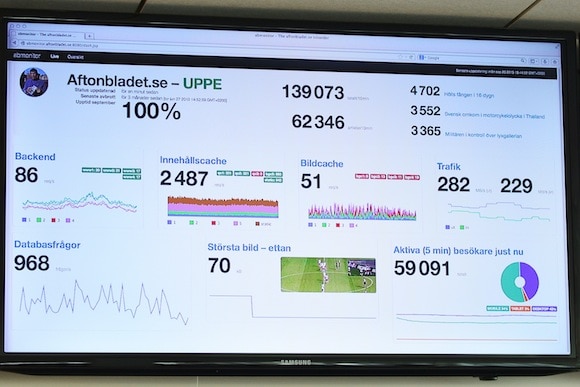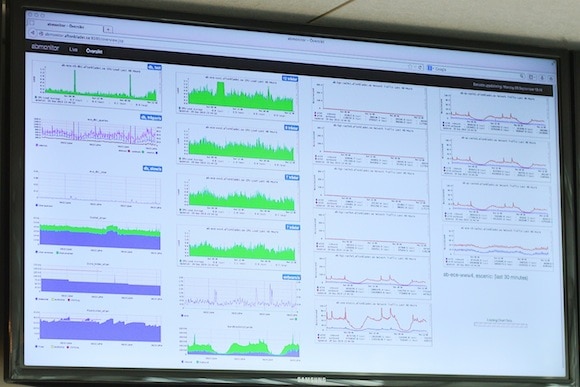3 million unique visitors each day, that is how much traffic Aftonbladet.se, the biggest website in Sweden, handles. Add to that the 15 TB of data the site pumps out daily and you get some idea of the scale of its operations. And keep in mind Sweden is a country with only 9.6 million people.
We at Pingdom visited Aftonbladet recently to find out how this cutting edge website is managed and monitored, and met with two of the guys that made this all happen: Christian Lizell, Systems Architect, and Tobias Järlund, Lead Developer. Here’s what we found out about how they and the rest of the team keep the site ticking.

Traffic
By almost any measure, Aftonbladet.se, the main online component of the newspaper, is big. According to the KIA Index, the site is number one in Sweden. The paper also ranks high when it comes to web TV (number two), mobile (number one), and mobile apps (number five).

According to Aftonbladet:
- The site gets around 3 million unique visitors per day.
- Traffic peaks at 100,000 requests per second when some news stories are published.
- Traffic is split over 50% mobile, 40% desktop, and about 10% tablet.
- Traffic results in about 15 TB per day in bandwidth, not including ads and TV-streams.
Metrics
When you enter the office at Aftonbladet it’s hard to miss the dashboards. Five computer displays are perched just below the ceiling at one end of the open office landscape. The displays show a number of dashboards, each one with critical information about some aspect of Aftonbladet’s web infrastructure.

Here’s a selection of what metrics Aftonbladet collects:
- Uptime in percentage.
- Time since last interruption.
- Number of clicks on the homepage in the last 10 minutes.
- The tree most clicked articles.
- Requests per second to the servers.
- Requests per second to the caches.
- Bandwidth in and out.
- SQL queries per second.
- The size of the biggest picture on the homepage.
- Number of active visitors.
- Size of the homepage in megabytes.
- Response time.
- And much more.

Infrastructure
In terms of hardware and software for keeping this running, Aftonbladet uses:
- Debian, MySQL, and Tomcat.
- The servers are Intel-based HP servers, but they also use virtual VMware servers for certain applications.
- Four machines deliver all the content for Aftonbladet.se.
- Editors enter articles into Escenic Content Engine.
- Content is not precompiled, but caching (with four machines running Varnish) is used extensively.
- A CDN (Content Delivery Network) is also used.

Tools
Aftonbladet is using a number of other tools to keep things running smoothly. In the toolbox we find:
- Google Analytics real time API.
- Nagios.
- Pingdom for uptime monitoring.
- Xymon.
- Several measuring- and monitoring tools developed in house.

We’d like to know about your setup
We would like to send a big thank you to Christian, Tobias, and everyone else we met while visiting Aftonbladet. Spending a few hours there really allowed us a glimpse into what it takes to run such a busy site. During our visit, news stories were published, and many in the office kept a close eye on the dashboards to see what was happening.
Visiting Aftonbladet was awesome, but we’re just as interested in your setup. What hardware and software do you use for your site and how do you keep it running? Let us know in the comments below or on Twitter.
Tobias Järlund is a front- and back-end web developer with a passion for web performance, scalability and security. He is the lead developer at Aftonbladet, where he’s trying to reshape the news industry from within.
Christian Lizell is a software developer with the consulting firm Athega. He’s a programmer since childhood, with a focus on the web since the mid-90s. Recently he’s been working with the architecture behind Aftonbladet.se and Svd.se with a focus on performance and uptime. To monitor systems and to visualize their status in real time with dashboards is dear to his heart.
























